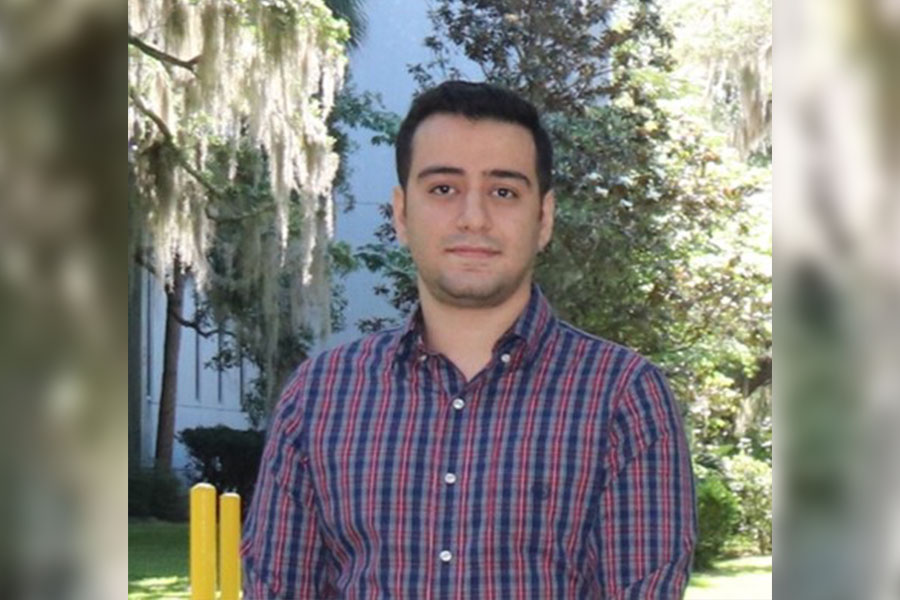Student Spotlight: Behrouz Ghazi Esfahani

Behrouz Ghazi Esfahani is a doctoral student in the Institute of Molecular Biophysics, part of Florida State University’s College of Arts and Sciences. He received his bachelor’s of science in Molecular Biology from the University of Kurdistan, one of the public universities in Iran. As a current research assistant, he is working on the project “Structure determination of the methionine tRNA synthetase (MetRS).” His past projects include “Optimizing the biological denitrification using nano-particles.”
Where are you from and what is your anticipated graduation date?
I’m from Isfahan, Iran. I’m set to graduate in the Fall of 2025.
What brought you to FSU?
To just name a few of them, great faculty, perfect research facilities and instrumentation, and the beautiful, friendly atmosphere throughout Florida State University. My high school friend, Mehran Sadeghi, who is also a current doctoral student, encouraged me to apply to FSU. He is in the last year of his computer science Ph.D. program and touted FSU’s amazing atmosphere.
What were the reasons you chose your area of study?
The department looks at biological micro-machines in high resolution to see how they are actually doing their natural “jobs.” There are many enzymes in our bodies that we can call micro-machines that are always active. One major group is the tRNA synthetases, which are responsible for matching a unique tRNA with the consequent unique amino acids. Their role is important because if they mismatch the tRNA and amino acids, the resulting protein wouldn’t be functional, and we would get sick! I found this fascinating, as this is a recent technological revolution and many of the things we do weren’t possible until recently. We can now observe numerous things for the first time with 2 – 3 angstrom resolutions, which was possible before using X-ray crystallography. The smaller the number, the better the degree of atomic resolution. I find it interesting being able to look at these organisms which are so tiny and important to life on earth, sometimes as the first observer.
Which, if any, faculty members have helped you during your time at FSU?
My principal investigator, professor of biological science Elizabeth Stroupe, is both supportive and informative. She is always there when I need help. Professor of biological science Scott Stagg is helping me learn different computational materials that were challenging for me as a molecular biologist. Since each faculty member has their own specialization, I am able to go to them with specific questions relating to minute parts of my project I’m having difficulty with. Specifically, Dr. Stroupe uses high resolution single-particle cryogenic electron microscopy (cryo-EM) for her research, so she is incredibly knowledgeable in my field of interest.
What drew you to the molecular biophysics doctoral program?
I have two main reasons I chose this program. First, the molecular biophysics program has the biological science imaging resource (BSIR) facility. The facility has sophisticated and updated equipment suitable for the research I am conducting, specifically, my interest in electron microscopy. Second, the faculty here are also known for their major impacts in the field. In particular, Scott Stagg was part of the team which first introduced the current software used for data collection through cryo-EM.
What first interested you about the research you’ve been conducting?
Electron microscopy, for sure. From the very first moment I was given a simple introduction to the topic in high school, I knew I wanted to explore this technique more. Being able to see microscopic organisms thrilled me, and I knew I wanted to go into a career where I could do this every day. The researchers that pioneered this field, Jacques Dubochet, Joachim Frank, and Richard Henderson, won the 2017 chemistry Nobel Prize and, since this field is still relatively young, there are many ways it can grow.
What current projects are you conducting? Have any of your previous projects been published?
I am working on two major projects. One involves the structural determination of the enzyme methionine tRNA synthetase, which is one of the important enzymes in protein synthesis in the cell. My other project is about comparing different sample preparation techniques for cryo-electron microscopy. For the later one, I will present a poster in the Biophysical Society meeting this year. Other than that, we haven’t published anything from my projects at FSU yet, but I hope we can do that in this coming year. In these, we are trying to understand the best way to prepare samples of proteins to optimize our research.
What are some of your goals, professional or otherwise?
My major goal would be to get more experience in my field and finally propose my own developments. As for my doctoral goal, I hope that I can identify the high-resolution structure of the enzyme “sulfite reductase,” which our lab has been working on for a long time. Sulfite reductases are enzymes involved in the metabolizing of sulfur, which occurs in all organisms from bacteria to animals. They act as electron pathways, and we want to figure out how this complex chemical transformation occurs.
What do you like to do in your free time?
I mostly enjoy watching historical or fictional series and movies. I also enjoy reading science or history-related books and playing the electric guitar.
What are your post-graduation plans?
I will be seeking a job which aligns with my interest in electron microscopy. I would like to live in a few different places throughout the United States before settling down in a permanent home. So, I have a job journey ahead of me!

